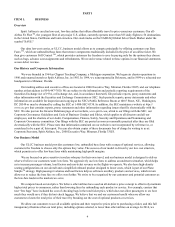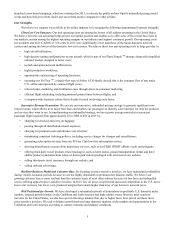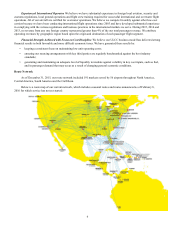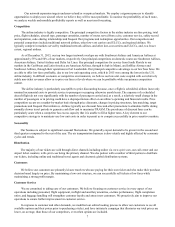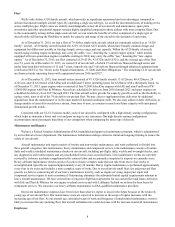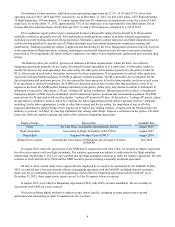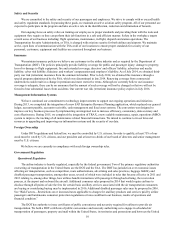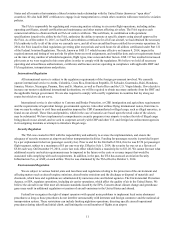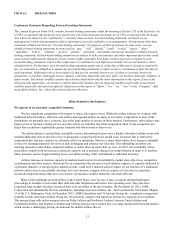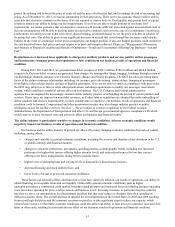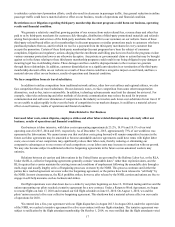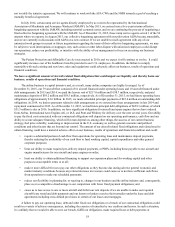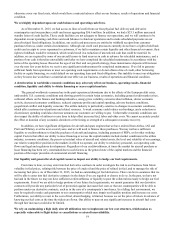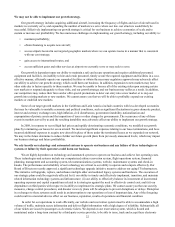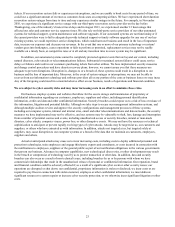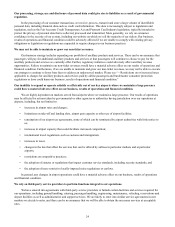Spirit Airlines 2015 Annual Report Download - page 14
Download and view the complete annual report
Please find page 14 of the 2015 Spirit Airlines annual report below. You can navigate through the pages in the report by either clicking on the pages listed below, or by using the keyword search tool below to find specific information within the annual report.14
Our growth and the success of our ULCC business model could stimulate competition in our markets through our
competitors’ development of their own ULCC strategies, new pricing policies designed to compete with ULCCs or new market
entrants. Any such competitor may have greater financial resources and access to less expensive sources of capital than we do,
which could enable them to operate their business with a lower cost structure, or enable them to operate with lower-marginal
revenues without substantial adverse effects, than we can. If these competitors adopt and successfully execute a ULCC business
model, we could be materially adversely affected. In 2015, Delta Airlines began to market and sell a "Basic Economy" fare
which was designed in part to provide its customers with a low base fare similar to Spirit. Other major carriers have announced
plans to market similar discounted fare classes.
There has been significant consolidation within the airline industry including, for example, the combinations of American
Airlines and US Airways, Delta Air Lines and Northwest Airlines, United Airlines and Continental Airlines and Southwest
Airlines and AirTran Airways. In the future, there may be additional consolidation in our industry. Any business combination
could significantly alter industry conditions and competition within the airline industry, which could have an adverse effect on
our business.
The extremely competitive nature of the airline industry could prevent us from attaining the level of passenger traffic or
maintaining the level of fares or revenues related to ancillary services required to sustain profitable operations in new and
existing markets and could impede our growth strategy, which could harm our operating results. Due to our relatively small
size, we are susceptible to a fare war or other competitive activities in one or more of the markets we serve, which could have a
material adverse effect on our business, results of operations and financial condition.
Our low cost structure is one of our primary competitive advantages, and many factors could affect our ability to
control our costs.
Our low cost structure is one of our primary competitive advantages. However, we have limited control over many of our
costs. For example, we have limited control over the price and availability of aircraft fuel, aviation insurance, airport costs and
related infrastructure taxes, the cost of meeting changing regulatory requirements and our cost to access capital or financing. In
addition, the compensation and benefit costs applicable to a significant portion of our employees are established by the terms of
our collective bargaining agreements. We cannot guarantee we will be able to maintain a cost advantage over our competitors.
If our cost structure increases and we are no longer able to maintain a sufficient cost advantage over our competitors, it could
have a material adverse effect on our business, results of operations and financial condition.
The airline industry is heavily influenced by the price and availability of aircraft fuel. Continued volatility in fuel costs
or significant disruptions in the supply of fuel, including hurricanes and other events affecting the Gulf Coast in
particular, could materially adversely affect our business, results of operations and financial condition.
Aircraft fuel costs represent our single largest operating cost, accounting for 28.3%, 38.9% and 40.2% of our total
operating expenses for 2015, 2014 and 2013, respectively. As such, our operating results are significantly affected by changes
in the availability and the cost of aircraft fuel, especially aircraft fuel refined in the U.S. Gulf Coast region, on which we are
highly dependent. Both the cost and the availability of aircraft fuel are subject to many meteorological, economic and political
factors and events occurring throughout the world, which we can neither control nor accurately predict. For example, a major
hurricane making landfall along the Gulf Coast could cause disruption to oil production, refinery operations and pipeline
capacity in that region, possibly resulting in significant increases in the price of aircraft fuel and diminished availability of
aircraft fuel supply. Any disruption to oil production, refinery operations, or pipeline capacity in the Gulf Coast region could
have a disproportionate impact on our operating results compared to other airlines that have more diversified fuel sources. Fuel
prices also may be affected by geopolitical and macroeconomic conditions and events that are outside of our control. Instability
within major oil producing regions, such as the Middle East, changes in demand from major petroleum users such as China,
and secular increases in competing energy sources are examples of these trends.
Aircraft fuel prices have been subject to high volatility, fluctuating substantially over the past several years. For example,
our fuel prices spiked at a high of $3.32 per gallon, in the second quarter of 2012, and have recently fallen as low as $1.57 per
gallon in the fourth quarter of 2015. We can not predict whether oil prices will remain at current low prices or for how long.
Due to the large proportion of aircraft fuel costs in our total operating cost base, even a relatively small increase or decrease in
the price of aircraft fuel can have a significant negative impact on our operating costs or revenues and on our business, results
of operations and financial condition.
Our fuel derivative activity, if any, may not reduce our fuel costs.
From time to time, we may enter into fuel derivative contracts in order to mitigate the risk to our business from future
volatility in fuel prices. Our derivatives may generally consist of United States Gulf Coast jet fuel swaps (jet fuel swaps) and
United States Gulf Coast jet fuel options (jet fuel options). Both jet fuel swaps and jet fuel options can be used at times to


